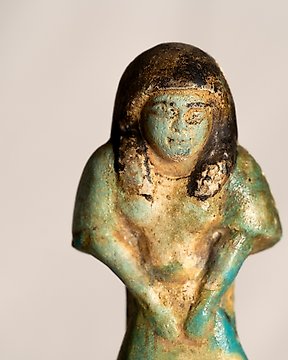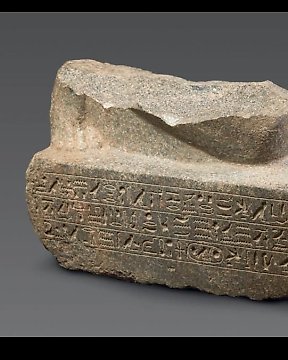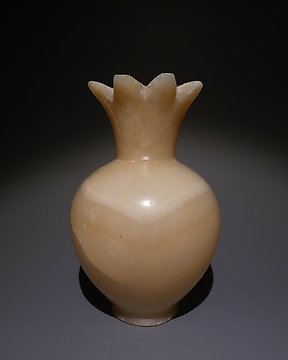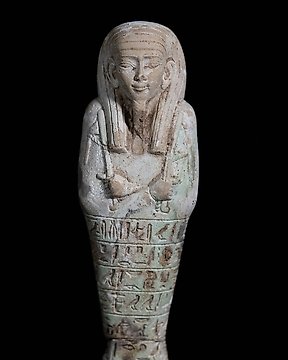Vendeur très professionnel, top +++×
查看翻译古埃及 滑石 带盖装饰的釉面科尔壶。公主的化妆容器。新王国,十八
编号 84870785
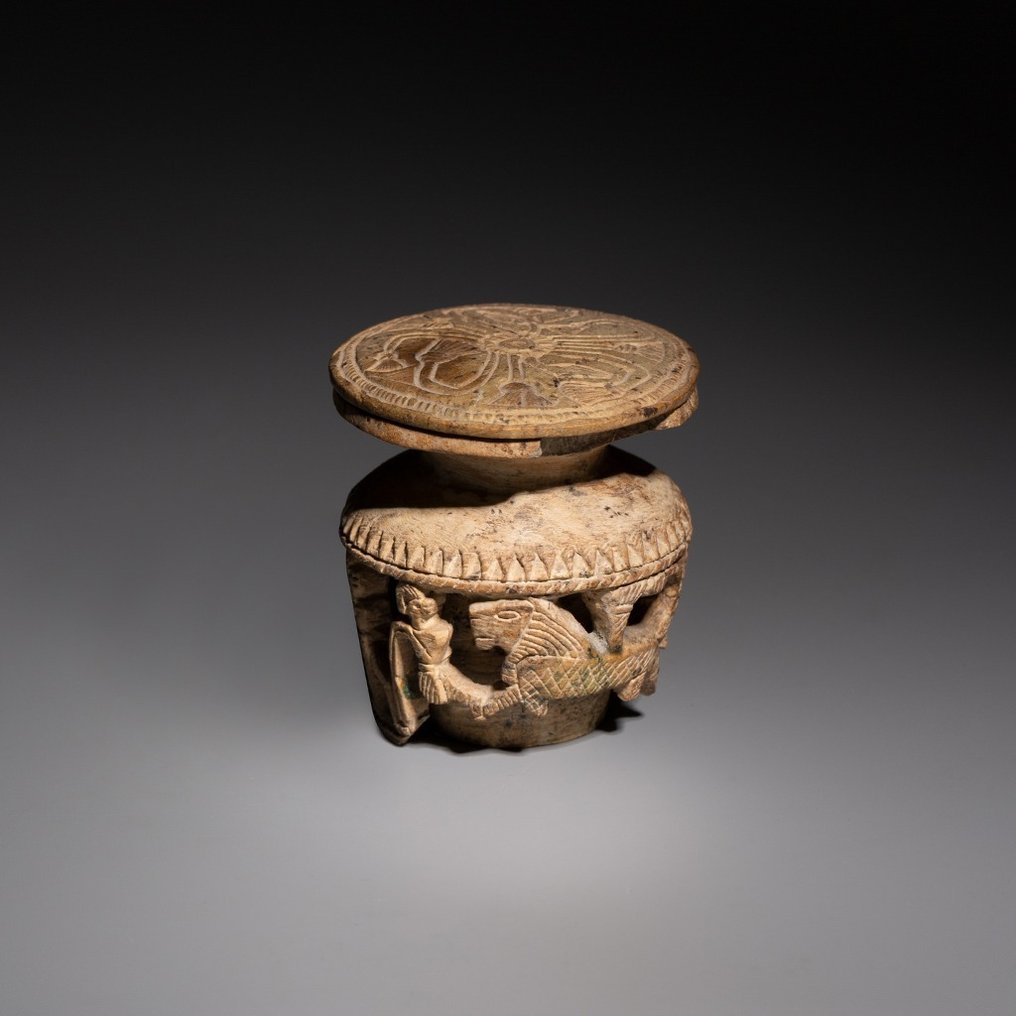


Kohl pot with openwork decoration
CULTURE: Ancient Egypt
PERIOD: New Kingdom, XVIII Dynasty, 1539 – 1478 BC
MATERIAL: Steatite
DIMENSIONS: Height 5.4 cm
PROVENANCE: Old private collection, Germany, before 1960.
CONDITION: In a good general state of preservation. Without restoration. The lid is intact. The pot has two chips to the lip and one on the side near the bottom. Some of the glazed green of the steatite is still to be found on the inside of the lid and on the lip of the vessel. Black dendrite marks can be seen on the surface of the vessel.
DESCRIPTION:
A pot to be used to hold cosmetics, carved with openwork decoration from two pieces of steatite, the container and the lid. Steatite is a soft metamorphic rock. This quality made it easy to use to fashion small amulets such as scarabs, and minute containers, but ones which were highly decorated. When the carving was completed the object was glazed, giving it a brilliant green turquoise finishing, quite different from the original white aspect.
The upper surface of the lid is decorated, while the underneath has a projection so that the lid fits snugly into the pot. A rosette decoration has been incised on the lid. This may be a lotus flower seen from above, from which come out ten stems with lotus flowers, some of which are open, and others still closed.
The lotus was one of the main territorial emblems of Egypt, alluding to Upper Egypt. The symbolic plant was represented as an offering to the gods; it was also an allusion to beauty, to life and to regeneration. A particular feature of the blue lotus was that this flower opened with the light at dawn and closed as night fell, to open at daybreak once again. This led to a strong association with the sun and cosmogonical stories. Sensual and erotic connotations are also present. It is common to find in Egyptian art depictions of people at banquets taking pleasure or being carried away by the magic of the perfume of these flowers. It is not surprising, therefore, that this type of dressing table objects should have such a decoration.
The pot has an inverted ovoid body with a pronounced mouth, a short neck and a wide flat lip. From the centre it has a circular orifice where liquid cosmetic can be introduced and stored. The external form is cylindrical, and the walls are incised with figurative openwork. One horizontal register runs around the vessel. Above and below this are two bands with diagonal marks, similar to a twine.
The most important figure in the register of decoration is a lion facing to the right. At its back we find again the image of a lotus flower. It faces two prisoners tied with their arms behind them. In line with Egyptian art and iconography, these prisoners could be Asian or Nubian, most probably the latter, given the type of hair depicted.
The image of a lion is common in Egyptian iconography to incarnate some deities and the king himself, who is often depicted hunting this feline as a way to represent domination over aggressive forces. It was a symbol of vigour, of regenerative powers as, when identified with the sun, it was born in the morning, died in the evening and this cycle was repeated every day. As a symbol of protection and powerful defence, it is represented on seats and beds to watch over the hours of rest of the owners. It is found as gargoyles on temples. The skin of this feline was also used for magical protective ends.
Behind the second prisoner, three lotus flowers blossom from a mound. The central one is erect while the other two are half bent over. The figures of a seated jackal and a falcon complete the scene. The jackal, which has a collar, is the representation of the deity Anubis, the guardian of tombs, associated with death and the afterlife, master of the necropolis and patron of embalmers. It was depicted with black skin, the colour of the discolouration of the corpse, and of fertile soils, the symbol of resurrection. The falcon is associated with the god Horus, the son of Osiris, and the governing of Egypt. Both animals, therefore, refers once again to the idea of rebirth and the power of the monarch.
It is common that objects such as this kohl pot, meant to be part of the funerary goods, should have references to rebirth and the afterlife. Even if they had been used during the lifetime of an Egyptian, the destiny of the object was to become part of the belongings that the person would take into the eternity of the Other World.
Kohl is a cosmetic with a base of ground up galena and other ingredients. It can be black or grey depending on the mixture used. It has traditionally used since the Bronze Age as a protection against diseases in the eyes. At the same time, as it darkens the eyelids, it protects them from the glare of the desert sun. Mothers applied kohl to the eyes of their new-born babies to “strengthen” them. In Ancient Egypt it was used as a make-up and for its bactericide properties.
The vases where it was stored, such as this example, have been found among funerary goods in tombs. During the 18th Dynasty it was frequent to find them decorated with images of protective deities. This is one of the most beautiful examples, given the iconography and the magical elements associated with life, power and rebirth. In short, it is a complete resume of Egyptian culture in one unique object.
PARALLELS:
- Kohl pot with openwork decoration. Glazed steatite. XVIII Dynasty. Height 5.1 cm. Brooklyn Museum, New York. Inv. 37.642E.
- Kohl pot with openwork decoration. Glazed steatite. XVIII Dynasty. Height 3.8 cm. Museum of Fine Arts Boston, Boston. Inv. 00.701a-b.
- Kohl pot with openwork decoration. Glazed steatite. XVIII Dynasty. Height 10. 5 cm. Auctioned at Christie´s New York, Antiquities, el 18 December 1998. Lot 17.
THE MINISTRY OF CULTURE FROM SPAIN ASKS ALL SELLERS FOR INVOICES OR OTHER DOCUMENTATION ABLE TO PROVE THE LEGALITY OF EACH ITEM BEFORE PROVIDING AN IMPORT OR EXPORT LICENSE.
Notes:
The seller guarantees that he acquired this piece according to all national and international laws related to the ownership of cultural property. Provenance statement seen by Catawiki.
The piece includes authenticity certificate.
The piece includes Spanish Export License (Passport for European Union) - If the piece is destined outside the European Union a substitution of the export permit should be requested.
卖家故事
Kohl pot with openwork decoration
CULTURE: Ancient Egypt
PERIOD: New Kingdom, XVIII Dynasty, 1539 – 1478 BC
MATERIAL: Steatite
DIMENSIONS: Height 5.4 cm
PROVENANCE: Old private collection, Germany, before 1960.
CONDITION: In a good general state of preservation. Without restoration. The lid is intact. The pot has two chips to the lip and one on the side near the bottom. Some of the glazed green of the steatite is still to be found on the inside of the lid and on the lip of the vessel. Black dendrite marks can be seen on the surface of the vessel.
DESCRIPTION:
A pot to be used to hold cosmetics, carved with openwork decoration from two pieces of steatite, the container and the lid. Steatite is a soft metamorphic rock. This quality made it easy to use to fashion small amulets such as scarabs, and minute containers, but ones which were highly decorated. When the carving was completed the object was glazed, giving it a brilliant green turquoise finishing, quite different from the original white aspect.
The upper surface of the lid is decorated, while the underneath has a projection so that the lid fits snugly into the pot. A rosette decoration has been incised on the lid. This may be a lotus flower seen from above, from which come out ten stems with lotus flowers, some of which are open, and others still closed.
The lotus was one of the main territorial emblems of Egypt, alluding to Upper Egypt. The symbolic plant was represented as an offering to the gods; it was also an allusion to beauty, to life and to regeneration. A particular feature of the blue lotus was that this flower opened with the light at dawn and closed as night fell, to open at daybreak once again. This led to a strong association with the sun and cosmogonical stories. Sensual and erotic connotations are also present. It is common to find in Egyptian art depictions of people at banquets taking pleasure or being carried away by the magic of the perfume of these flowers. It is not surprising, therefore, that this type of dressing table objects should have such a decoration.
The pot has an inverted ovoid body with a pronounced mouth, a short neck and a wide flat lip. From the centre it has a circular orifice where liquid cosmetic can be introduced and stored. The external form is cylindrical, and the walls are incised with figurative openwork. One horizontal register runs around the vessel. Above and below this are two bands with diagonal marks, similar to a twine.
The most important figure in the register of decoration is a lion facing to the right. At its back we find again the image of a lotus flower. It faces two prisoners tied with their arms behind them. In line with Egyptian art and iconography, these prisoners could be Asian or Nubian, most probably the latter, given the type of hair depicted.
The image of a lion is common in Egyptian iconography to incarnate some deities and the king himself, who is often depicted hunting this feline as a way to represent domination over aggressive forces. It was a symbol of vigour, of regenerative powers as, when identified with the sun, it was born in the morning, died in the evening and this cycle was repeated every day. As a symbol of protection and powerful defence, it is represented on seats and beds to watch over the hours of rest of the owners. It is found as gargoyles on temples. The skin of this feline was also used for magical protective ends.
Behind the second prisoner, three lotus flowers blossom from a mound. The central one is erect while the other two are half bent over. The figures of a seated jackal and a falcon complete the scene. The jackal, which has a collar, is the representation of the deity Anubis, the guardian of tombs, associated with death and the afterlife, master of the necropolis and patron of embalmers. It was depicted with black skin, the colour of the discolouration of the corpse, and of fertile soils, the symbol of resurrection. The falcon is associated with the god Horus, the son of Osiris, and the governing of Egypt. Both animals, therefore, refers once again to the idea of rebirth and the power of the monarch.
It is common that objects such as this kohl pot, meant to be part of the funerary goods, should have references to rebirth and the afterlife. Even if they had been used during the lifetime of an Egyptian, the destiny of the object was to become part of the belongings that the person would take into the eternity of the Other World.
Kohl is a cosmetic with a base of ground up galena and other ingredients. It can be black or grey depending on the mixture used. It has traditionally used since the Bronze Age as a protection against diseases in the eyes. At the same time, as it darkens the eyelids, it protects them from the glare of the desert sun. Mothers applied kohl to the eyes of their new-born babies to “strengthen” them. In Ancient Egypt it was used as a make-up and for its bactericide properties.
The vases where it was stored, such as this example, have been found among funerary goods in tombs. During the 18th Dynasty it was frequent to find them decorated with images of protective deities. This is one of the most beautiful examples, given the iconography and the magical elements associated with life, power and rebirth. In short, it is a complete resume of Egyptian culture in one unique object.
PARALLELS:
- Kohl pot with openwork decoration. Glazed steatite. XVIII Dynasty. Height 5.1 cm. Brooklyn Museum, New York. Inv. 37.642E.
- Kohl pot with openwork decoration. Glazed steatite. XVIII Dynasty. Height 3.8 cm. Museum of Fine Arts Boston, Boston. Inv. 00.701a-b.
- Kohl pot with openwork decoration. Glazed steatite. XVIII Dynasty. Height 10. 5 cm. Auctioned at Christie´s New York, Antiquities, el 18 December 1998. Lot 17.
THE MINISTRY OF CULTURE FROM SPAIN ASKS ALL SELLERS FOR INVOICES OR OTHER DOCUMENTATION ABLE TO PROVE THE LEGALITY OF EACH ITEM BEFORE PROVIDING AN IMPORT OR EXPORT LICENSE.
Notes:
The seller guarantees that he acquired this piece according to all national and international laws related to the ownership of cultural property. Provenance statement seen by Catawiki.
The piece includes authenticity certificate.
The piece includes Spanish Export License (Passport for European Union) - If the piece is destined outside the European Union a substitution of the export permit should be requested.
卖家故事
- 750
- 6
- 0
Photos trop contrastées pour bien percevoir les défauts, mais ces défauts étaient visibles pour autant. Le "Bon état" est trompeur. Sinon, envoi rapide et correctement emballé. Frais de port exagérés.
查看翻译Great communication, delivery and product. Came with a well made certificate of authenticity and good packaging. Overall very happy with the purchase! Delivery is a bit expensive, but I recommend it
查看翻译Magnifique témoin du passé, envoyé avec tous les justificatifs, impeccable. Encore une fois très satisfait, un grand merci
查看翻译Thank you for the Special offer and the fast shipping of this excellent piece of art!
查看翻译very good description of the object, very good price for this rare item,. Fast sending (has been at my place 2 days after buying!). Definitely would buy again.
查看翻译Sehr schön
查看翻译As described, perfect logistic
查看翻译great seller, everything came as should with certificate of authenticity
查看翻译Exceptionally well packaged, description aligned with positing received
查看翻译Really precious, but without sound...
查看翻译Painting well packed and rapidly sent!
查看翻译sempre grande rapidità e professionalità
查看翻译parfait bien reçu, merci
查看翻译Very satisfied with the small Greek Lekythos. As always (we have already bought several items from Bagot), the object was wrapped and sent immediately and with the greatest care.
查看翻译Perfect, excellent condition, good packaging, the parcel arrived without any problems… all is perfect as usual. Thank you very much and wait for an other nice piece like this one. Gilles.
查看翻译+++ Top vendeur professionnel comme d'habitude
查看翻译Embora o custo de transporte esteja acima da média foi, realmente, muito bem executado e em embalagem cuidada. Expeditos e profissionais. Recomendo
查看翻译Snel en correct en goed verpakt verzonden
查看翻译oggetto bellissimo, fedele alla descrizione, venditore affidabile
查看翻译Very nice piece and fast delivery
查看翻译Everything ok, top seller! Thank you again!
查看翻译very beautiful and fast shipping!thank you!
查看翻译Excelent, very good piece++++
查看翻译Vendedor increíble muy buenos he comprado muchas veces todo perfecto. Muchas gracias
查看翻译